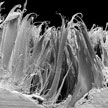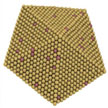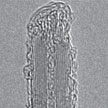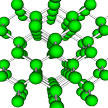Showing Spotlights 97 - 104 of 217 in category All (newest first):
 Observations made on a fern and an insect have led researchers to develop a nanofur structure that significantly reduces fluid drag. Both have surfaces covered by high density hairs which allow them to keep an air layer under water. This enables the bug to move nimbly and swiftly through the water by reducing the drag on its surface. Based on these observations, researchers have developed a very inexpensive, highly scalable method to produce a superhydrophobic, air retaining biomimetic surface - a 'nanofur' - which shows not only a high long-term stability but also a high resistance against additional applied pressure.
Observations made on a fern and an insect have led researchers to develop a nanofur structure that significantly reduces fluid drag. Both have surfaces covered by high density hairs which allow them to keep an air layer under water. This enables the bug to move nimbly and swiftly through the water by reducing the drag on its surface. Based on these observations, researchers have developed a very inexpensive, highly scalable method to produce a superhydrophobic, air retaining biomimetic surface - a 'nanofur' - which shows not only a high long-term stability but also a high resistance against additional applied pressure.
Jun 22nd, 2015
 According to Planck's law, the emittance of a non-reflective black object - a blackbody - defines the maximum level of thermal emittance from an arbitrary object. Planck's law has been challenged in recent decades by predictions and successful demonstrations of the radiative heat transfer between objects separated by nanoscale gaps that deviate significantly from the law predictions. Researchers have now demonstrated another way to modify the object thermal emission spectrum and to force it to deviate from the one predicted by Planck's law.
According to Planck's law, the emittance of a non-reflective black object - a blackbody - defines the maximum level of thermal emittance from an arbitrary object. Planck's law has been challenged in recent decades by predictions and successful demonstrations of the radiative heat transfer between objects separated by nanoscale gaps that deviate significantly from the law predictions. Researchers have now demonstrated another way to modify the object thermal emission spectrum and to force it to deviate from the one predicted by Planck's law.
Jun 2nd, 2015
 Novel materials designed and fabricated with the help of nanotechnologies offer the promise of radical technological development. Many of these will improve our quality of life, and develop our economies, but all will be measured against the overarching principle that we do not make some error, and harm ourselves and our environment by exposure to new forms of hazard. A publication explores recent developments in nanomaterials research, and possibilities for safe, practical and resource-efficient applications.
Novel materials designed and fabricated with the help of nanotechnologies offer the promise of radical technological development. Many of these will improve our quality of life, and develop our economies, but all will be measured against the overarching principle that we do not make some error, and harm ourselves and our environment by exposure to new forms of hazard. A publication explores recent developments in nanomaterials research, and possibilities for safe, practical and resource-efficient applications.
Mar 27th, 2015
 At the end of their product life cycle, nanomaterials can enter waste treat ment plants and landfills via diverse waste streams. Little, however, is known about how nanomaterials behave in the disposal phase and whether potential environmental or health risks arise. The current assumption is that stable nanoparticles are neither chemically nor physically altered in waste incineration plants and that they accumulate especially in the residues (e.g. slag). These residues are ultimately dumped. The disposal problem in the case of stable nanoparticles is therefore merely shifted to the subsequent steps in the waste treatment process.
At the end of their product life cycle, nanomaterials can enter waste treat ment plants and landfills via diverse waste streams. Little, however, is known about how nanomaterials behave in the disposal phase and whether potential environmental or health risks arise. The current assumption is that stable nanoparticles are neither chemically nor physically altered in waste incineration plants and that they accumulate especially in the residues (e.g. slag). These residues are ultimately dumped. The disposal problem in the case of stable nanoparticles is therefore merely shifted to the subsequent steps in the waste treatment process.
Jan 27th, 2015
 Gold-copper alloys are very popular catalysts in nanotechnology, for instance to efficiently convert carbon dioxide or to help fabricate a more powerful and longer lasting fuel cell material. This alloy exhibits novel physical and chemical properties at the nanoscale. Although the Au-Cu alloy has been extensively studied in the literature both at the bulk and nanoscales, the prediction of phase diagrams at the nanoscale has been missing. A new paper present sthe phase diagram of Au-Cu at the nanoscale for the relevant distinct polyhedral morphologies of nanoparticles at sizes 4 nm and 10 nm.
Gold-copper alloys are very popular catalysts in nanotechnology, for instance to efficiently convert carbon dioxide or to help fabricate a more powerful and longer lasting fuel cell material. This alloy exhibits novel physical and chemical properties at the nanoscale. Although the Au-Cu alloy has been extensively studied in the literature both at the bulk and nanoscales, the prediction of phase diagrams at the nanoscale has been missing. A new paper present sthe phase diagram of Au-Cu at the nanoscale for the relevant distinct polyhedral morphologies of nanoparticles at sizes 4 nm and 10 nm.
Oct 29th, 2014
 The European Commission has published a compendium 'Nanotechnologies: Principles, Applications, Implications and Hands-on Activities' that has been specifically developed to provide the educational communities with relevant, accurate and updated materials to inform, motivate and inspire young people to know more about nanosciences and nanotechnologies concepts and applications. This resource has been developed within the context of the European research project Nanoyou, and it has been enriched with numerous and multifaceted inputs, reflections and insights on societal issues, also provided by the European project TimeforNano.
The European Commission has published a compendium 'Nanotechnologies: Principles, Applications, Implications and Hands-on Activities' that has been specifically developed to provide the educational communities with relevant, accurate and updated materials to inform, motivate and inspire young people to know more about nanosciences and nanotechnologies concepts and applications. This resource has been developed within the context of the European research project Nanoyou, and it has been enriched with numerous and multifaceted inputs, reflections and insights on societal issues, also provided by the European project TimeforNano.
Oct 6th, 2014
 So far, it has been generally accepted knowledge that boron nitride nanotubes (BNNTs) are highly inert to oxidative treatments and can only be covalently modified by highly reactive species. By contrast, oxidation of carbon nanotubes has been proven very convenient and fundamentally important to modify the nanotube structure and morphology via controlled corrosive effects. Now, researchers have discovered a convenient method to disperse and chemically modify the morphology of BNNTs by sonication in aqueous ammonia solutions.
So far, it has been generally accepted knowledge that boron nitride nanotubes (BNNTs) are highly inert to oxidative treatments and can only be covalently modified by highly reactive species. By contrast, oxidation of carbon nanotubes has been proven very convenient and fundamentally important to modify the nanotube structure and morphology via controlled corrosive effects. Now, researchers have discovered a convenient method to disperse and chemically modify the morphology of BNNTs by sonication in aqueous ammonia solutions.
Aug 13th, 2014
 Thermoelectric materials hold great promise for turning waste heat back into useful power and are touted for use in hybrid cars, new and efficient refrigerators, and other cooling or heating applications. But they have one big drawback: they are very inefficient. Since thermoelectric devices work by maintaining a temperature difference between their different sides, it is important that the used materials have low conductivity, i.e. are good thermal insulators.
Thermoelectric materials hold great promise for turning waste heat back into useful power and are touted for use in hybrid cars, new and efficient refrigerators, and other cooling or heating applications. But they have one big drawback: they are very inefficient. Since thermoelectric devices work by maintaining a temperature difference between their different sides, it is important that the used materials have low conductivity, i.e. are good thermal insulators.
Jul 7th, 2014
 Observations made on a fern and an insect have led researchers to develop a nanofur structure that significantly reduces fluid drag. Both have surfaces covered by high density hairs which allow them to keep an air layer under water. This enables the bug to move nimbly and swiftly through the water by reducing the drag on its surface. Based on these observations, researchers have developed a very inexpensive, highly scalable method to produce a superhydrophobic, air retaining biomimetic surface - a 'nanofur' - which shows not only a high long-term stability but also a high resistance against additional applied pressure.
Observations made on a fern and an insect have led researchers to develop a nanofur structure that significantly reduces fluid drag. Both have surfaces covered by high density hairs which allow them to keep an air layer under water. This enables the bug to move nimbly and swiftly through the water by reducing the drag on its surface. Based on these observations, researchers have developed a very inexpensive, highly scalable method to produce a superhydrophobic, air retaining biomimetic surface - a 'nanofur' - which shows not only a high long-term stability but also a high resistance against additional applied pressure.
 Subscribe to our Nanotechnology Spotlight feed
Subscribe to our Nanotechnology Spotlight feed





